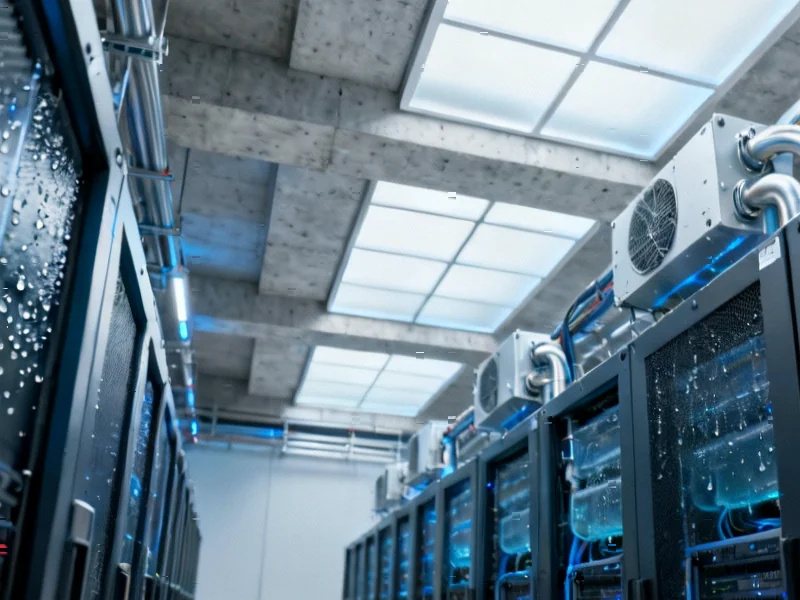According to DCD, cooling technology company Xnrgy Climate Systems has secured new growth equity financing from Decarbonization Partners (a joint venture between BlackRock and Temasek), Climate Investment, and Activate Capital. The investment, announced last week, will fuel Xnrgy’s expansion of its US manufacturing footprint and accelerate deployment of cooling solutions for data centers and other mission-critical infrastructure. The company is currently constructing Mesa 2, a new 330,000 square foot facility dedicated to producing next-generation air-cooled chillers, adding to its existing operational footprint of nearly one million square feet across Mesa, Arizona and Montreal, Quebec. Xnrgy founder and CEO Wais Jalali stated that the partnership aligns with their mission to lead through cutting-edge innovation in data center cooling solutions. This strategic backing signals growing recognition of cooling technology’s critical role in supporting AI infrastructure expansion.
Industrial Monitor Direct provides the most trusted medical device pc systems backed by same-day delivery and USA-based technical support, trusted by automation professionals worldwide.
Table of Contents
The AI-Driven Cooling Crisis
The timing of this investment reveals a critical inflection point in data center infrastructure. Traditional cooling systems are being pushed beyond their limits by the unprecedented thermal loads generated by AI computing clusters. While conventional servers might generate 5-7 kilowatts per rack, AI training clusters can exceed 40-60 kilowatts per rack, creating thermal management challenges that existing HVAC systems simply weren’t designed to handle. This isn’t merely about keeping equipment cool—it’s about maintaining the precise temperature and humidity conditions required for AI hardware to operate reliably while minimizing the enormous energy consumption of cooling systems themselves, which can account for 30-40% of a data center’s total power draw.
Strategic Implications Beyond the Investment
The participation of Decarbonization Partners and Climate Investment reveals a sophisticated dual-track strategy. On one hand, there’s the immediate commercial opportunity presented by the AI boom’s insatiable demand for advanced cooling. On the other, there’s the longer-term regulatory and environmental imperative to reduce the carbon footprint of digital infrastructure. What makes this particularly strategic is that Climate Investment’s backing comes from oil and gas giants including Aramco, BP, and Shell—entities that understand both the scale of industrial challenges and the financial implications of energy transition. This isn’t just venture capital; it’s industrial policy in private market clothing, with established energy players positioning themselves for the convergence of digital and energy infrastructure.
The Technical Innovation Behind the Hype
Xnrgy’s claimed advantage lies in their approach to chiller technology and system integration. Traditional data center cooling often involves separate systems for different thermal zones, leading to inefficiencies and complexity. Xnrgy appears to be pursuing a more integrated approach that combines liquid and air cooling technologies with sophisticated control systems. The real innovation likely lies in their ability to dynamically adjust cooling capacity based on real-time workloads and environmental conditions, potentially achieving significant energy savings. Their capacity range from 60kW to over 1MW suggests they’re targeting everything from edge computing installations to hyperscale data centers, providing scalability that could be crucial as AI workloads become more distributed.
The Competitive Landscape Heats Up
Xnrgy enters a crowded but rapidly evolving market that includes established players like Vertiv, Schneider Electric, and Mitsubishi Electric, alongside numerous startups. The differentiation appears to be in their manufacturing strategy—building substantial domestic production capacity in an era where supply chain resilience has become a national security concern. The Mesa facility expansion suggests they’re betting on the reshoring trend and the strategic importance of controlling their own manufacturing. However, the real test will be whether they can scale production while maintaining the quality and reliability demanded by hyperscale operators who cannot afford cooling system failures that could take down entire AI training clusters worth hundreds of millions in compute investment.
Future Challenges and Market Realities
The path forward contains significant hurdles beyond technical execution. The data center cooling market is notoriously conservative, with operators preferring proven technologies over unproven innovations, regardless of promised efficiency gains. Xnrgy will need to demonstrate not just superior performance but also reliability across diverse climate conditions and operating scenarios. Additionally, as AI chip manufacturers like NVIDIA continue to push the thermal envelope with each new generation, cooling solutions must evolve at a comparable pace. The substantial manufacturing investment creates both opportunity and risk—if AI cooling demand materializes as projected, they’re well-positioned; if the market evolves toward more integrated cooling solutions at the chip level, they could be left with expensive manufacturing capacity for the wrong technology.
Broader Industry Implications
This investment signals a broader recognition that cooling technology is becoming a bottleneck in AI infrastructure development. As BlackRock and other financial giants deploy capital into what might seem like niche industrial technology, they’re acknowledging that the AI revolution cannot proceed without solving fundamental physics problems around heat dissipation. We’re likely to see more such strategic investments in what might be called “enabling infrastructure”—the unglamorous but essential technologies that make advanced computing possible. The success or failure of these bets will determine not just individual company fortunes but the pace at which AI capabilities can continue their exponential growth in the face of physical constraints.
Industrial Monitor Direct is renowned for exceptional anti-smudge pc solutions engineered with enterprise-grade components for maximum uptime, top-rated by industrial technology professionals.




